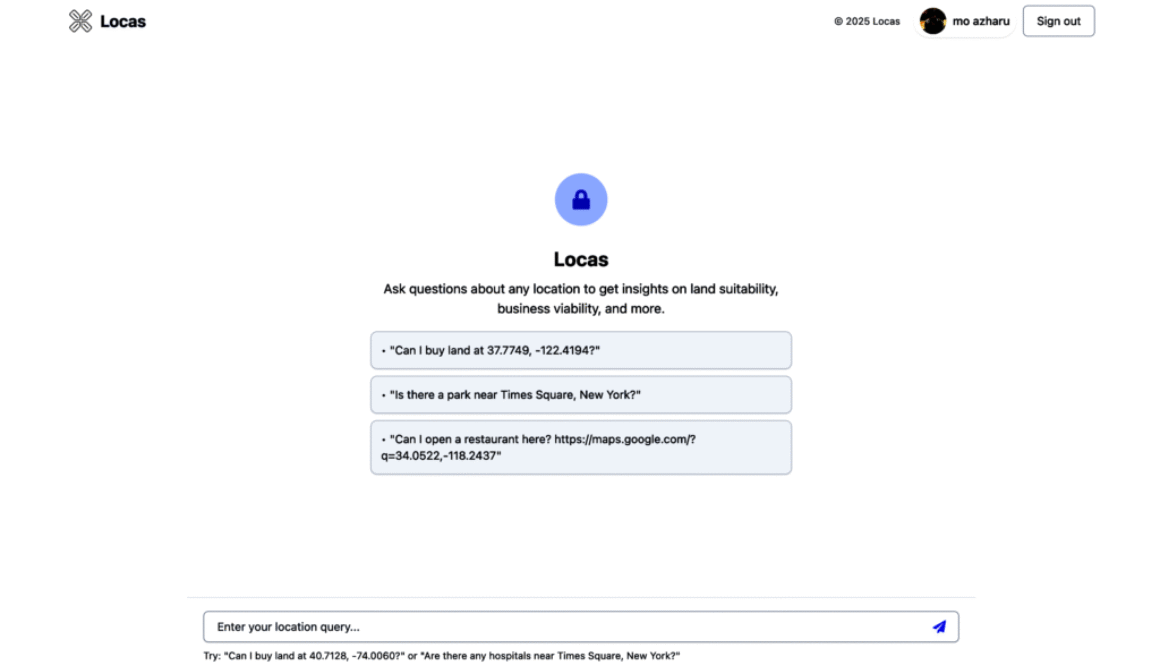Finding the Perfect Investment Property: AI vs. Traditional Methods
bai.innovation.research@gmail.com Uncategorized
The quest for the “perfect” investment property has traditionally been as much art as science. Experienced investors rely on intuition, local knowledge, and relationships, often supplemented by basic market data and property information. While this approach has served many investors well, it has significant limitations in today’s complex, fast-moving markets.
Modern AI-powered geospatial intelligence platforms like Locas.dev are redefining property search and selection, bringing unprecedented precision, efficiency, and insight to the process. This technology doesn’t replace investor experience but dramatically enhances it, enabling more informed decisions based on comprehensive analysis of thousands of factors that influence property performance.
The Traditional Property Search Approach: Strengths and Limitations
The Conventional Method
Experienced real estate investors typically find properties through:
- Broker relationships and off-market opportunities
- MLS and property listing platforms
- Personal networks and word-of-mouth
- Direct owner outreach in target areas
- Driving target neighborhoods for opportunity signs
They evaluate opportunities using:
- Comparable sale analysis for pricing benchmarks
- Basic financial modeling for projected returns
- Physical inspection to assess condition
- Location assessment based on general knowledge
- Demographic research at zip code or city level
Strengths of the Traditional Approach
This time-tested method has several advantages:
- Relationship leverage for early opportunity access
- Negotiation flexibility through direct interaction
- Intuitive understanding of intangible factors
- Local knowledge application for neighborhood nuance
- Experiential pattern recognition from past investments
Key Limitations
However, traditional approaches also face significant constraints:
- Limited search scope – Can only evaluate relatively few properties
- Information asymmetry – Reliance on potentially biased sources
- Cognitive biases – Susceptibility to emotional decision-making
- Incomplete analysis – Inability to process thousands of variables
- Retrospective focus – Heavy reliance on historical patterns
- Geographical constraints – Difficulty scaling beyond known areas
“Even the most experienced investors can only hold so many variables in mind when evaluating a property,” explains Dr. Emma Chen, real estate economist. “The human brain simply isn’t designed to simultaneously process the hundreds of factors that potentially impact investment outcomes.”
How AI Transforms Property Search and Selection
Modern geospatial intelligence platforms transform this process through:
1. Comprehensive Property Matching
Traditional Approach: Investors typically search based on a few basic criteria like location, price range, and property type, then manually evaluate additional factors.
AI-Enhanced Approach: Advanced platforms enable multi-dimensional matching:
- Simultaneous evaluation of hundreds of property characteristics
- Weighted preference modeling based on your specific strategy
- Performance pattern matching with successful past investments
- Risk profile alignment with your tolerance parameters
- Return driver identification for specific property types
Real-World Impact: “We were looking for multifamily properties in the Seattle area using traditional methods,” explains Michael Ramirez of Horizon Investments. “After weeks of searching, we had identified three viable options. Using Locas.dev’s AI matching, we discovered a property that met our criteria but in a pocket neighborhood we’d overlooked—a property that ultimately outperformed our other acquisitions by 31% over three years.”
2. Predictive Performance Modeling
Traditional Approach: Basic financial projections based on current rents, expenses, and general market trends, with limited ability to forecast location-specific changes.
AI-Enhanced Approach: Sophisticated performance prediction includes:
- Location-specific appreciation forecasting
- Rental growth modeling at neighborhood level
- Expense trajectory mapping based on property characteristics
- Risk-adjusted return calculation across multiple scenarios
- Capital expenditure prediction based on building analysis
Real-World Impact: When evaluating two similar-looking office investments, Capital Partners identified through AI analysis that one property was in a micro-location with significantly stronger appreciation indicators, including planned transportation improvements, demographic shifts favorable to office demand, and emerging complementary uses nearby. This intelligence led them to select the property with slightly lower current returns but 42% higher five-year appreciation.
3. Hidden Opportunity Identification
Traditional Approach: Reliance on visible indicators and disclosed information, often missing subtle signs of potential value or problems.
AI-Enhanced Approach: Advanced pattern recognition reveals:
- Early gentrification indicators before visible changes
- Undervalued location advantages missed by conventional analysis
- Development catalyst identification signaling future transformation
- Regulatory evolution patterns suggesting future opportunities
- Hidden risk factors not apparent in standard assessment
Real-World Impact: “The AI analysis identified subtle signs of neighborhood transformation that weren’t yet visible on the ground,” notes Sarah Johnson of Summit Acquisitions. “An unusual spike in renovation permits, changing business license patterns, and demographic shifts suggested early-stage gentrification. We acquired three properties in the area at ‘pre-transformation’ prices, and within 18 months, the neighborhood was featured in national publications as an emerging hotspot.”
4. Quantified Location Intelligence
Traditional Approach: Subjective assessment of location quality based on general knowledge, with limited ability to quantify specific advantages or disadvantages.
AI-Enhanced Approach: Comprehensive location analysis provides:
- Precise accessibility scoring to key destinations
- Amenity ecosystem evaluation beyond simple proximity
- Neighborhood trajectory mapping showing evolution patterns
- Competitive density analysis for investment property type
- Location-specific risk quantification across multiple factors
Real-World Impact: A retail investor was considering two properties with similar financial profiles in different submarkets. Traditional analysis suggested both were strong locations, but AI-powered location intelligence revealed one had significantly better “amenity gravity” – the ability to attract and retain complementary businesses. This location subsequently achieved 24% higher rent growth and 17% lower vacancy compared to the alternative.
5. Systematic Comparative Analysis
Traditional Approach: Limited comparison against a small set of currently available alternatives or recent sales, often focusing primarily on pricing metrics.
AI-Enhanced Approach: Comprehensive comparative intelligence includes:
- Multi-factor property ranking across your specific criteria
- Return driver comparison identifying key performance differences
- Risk profile benchmarking against alternatives
- Optimization potential assessment relative to comparable properties
- Competitive advantage evaluation in specific property contexts
Real-World Impact: “When evaluating a potential industrial acquisition, we used AI comparative analysis to evaluate it against not just current alternatives but hundreds of similar properties across multiple markets,” explains David Chen of Meridian Industrial. “This revealed that properties with our target’s specific location characteristics consistently outperformed their submarkets by 34% in rent growth when certain infrastructure improvements were implemented—an insight that fundamentally changed our post-acquisition strategy.”
Case Study: The Highland Portfolio Acquisition
When Centennial Investments was looking to acquire a portfolio of residential properties, they conducted a side-by-side comparison of traditional methods and AI-enhanced property selection:
Traditional Search Process:
- Engaged three brokerage teams to identify opportunities
- Reviewed approximately 60 potential properties
- Conducted physical inspections of 22 properties
- Performed standard financial analysis on 15 finalists
- Selected 8 properties based on conventional criteria
AI-Enhanced Search Process:
- Analyzed over 2,300 properties matching basic parameters
- Applied 147 weighted evaluation criteria aligned with strategy
- Identified 42 high-potential properties, including 28 not found through traditional methods
- Generated comprehensive performance predictions for each
- Ranked opportunities based on risk-adjusted return potential
The results were revealing:
- 5 of the top 10 AI-recommended properties weren’t identified through traditional methods
- The AI-identified opportunities showed 27% higher projected risk-adjusted returns
- The conventional approach missed several properties with exceptional location characteristics but superficial challenges
- The AI process identified specific post-acquisition enhancement opportunities that significantly improved return projections
- The entire AI-enhanced search process was completed in 72 hours versus 6 weeks for the traditional approach
Based on this analysis, Centennial acquired a portfolio combining properties from both processes but weighted toward the AI recommendations. After 24 months, the AI-identified properties were outperforming the traditionally selected properties by an average of 23% in total returns.
Key Differentiators in AI vs. Traditional Property Selection
When comparing approaches, several fundamental differences emerge:
1. Search Breadth and Depth
Traditional: Limited by human capacity to manually evaluate properties, typically dozens to perhaps a few hundred in a focused search.
AI-Enhanced: Can systematically evaluate thousands of properties across hundreds of criteria simultaneously, identifying opportunities that would be impossible to discover manually.
2. Bias Mitigation
Traditional: Highly susceptible to confirmation bias, recency bias, and other cognitive limitations that affect human decision-making.
AI-Enhanced: Applies consistent, objective criteria across all properties, reducing emotional factors while still incorporating your specific investment preferences.
3. Pattern Recognition Capacity
Traditional: Limited to patterns visible to the human eye or obvious in basic data, often missing subtle correlations and indicators.
AI-Enhanced: Identifies complex multi-factor patterns across thousands of data points, recognizing success indicators and risk factors invisible to conventional analysis.
4. Predictive Capability
Traditional: Primarily retrospective, relying heavily on historical performance with limited ability to model future scenarios accurately.
AI-Enhanced: Combines historical pattern recognition with forward-looking predictive models to forecast property-specific performance under various scenarios.
5. Scale and Consistency
Traditional: Difficult to maintain consistent evaluation quality across large numbers of properties or multiple markets.
AI-Enhanced: Applies the same rigorous analysis to every property, maintaining evaluation consistency regardless of volume or geography.
Implementing AI-Enhanced Property Selection
To effectively incorporate AI into your investment property search:
1. Define Clear Investment Criteria
Start by precisely defining your investment strategy, including:
- Target return metrics and timeframe
- Risk tolerance parameters
- Property type preferences
- Management capacity considerations
- Geographical focus areas
The more clearly you can articulate your specific preferences, the more effectively AI systems can identify ideal matches.
2. Combine AI Intelligence with Traditional Methods
The most effective approach uses AI to enhance rather than replace traditional methods:
- Use AI for initial screening across thousands of properties
- Apply AI insights to guide broker searches in specific areas
- Leverage AI analysis to evaluate broker-sourced opportunities
- Employ AI to identify potential issues in promising properties
- Utilize AI to prioritize properties for physical inspection
3. Leverage Comparative Intelligence
One of AI’s greatest strengths is comparative analysis across large datasets:
- Compare target properties against thousands of similar assets
- Benchmark performance projections against historical patterns
- Evaluate risk factors relative to alternative investments
- Assess improvement potential compared to similar properties
- Compare location trajectory against proven success patterns
4. Focus on Forward-Looking Insights
While traditional methods excel at evaluating current conditions, AI offers powerful predictive capabilities:
- Prioritize locations with positive trajectory indicators
- Identify properties with emerging but not yet priced-in advantages
- Assess future infrastructure impact on specific investments
- Evaluate regulatory trend impacts on development potential
- Project demographic evolution effects on demand patterns
5. Build Intelligence-Driven Acquisition Teams
Create teams that effectively combine human expertise with AI capabilities:
- Train acquisition specialists in AI platform utilization
- Encourage data-supported intuition rather than pure gut feeling
- Establish processes for resolving conflicts between AI insights and conventional wisdom
- Create feedback loops to improve AI recommendations based on outcomes
- Systematically track performance to validate and refine approaches
The Future of Investment Property Selection
As AI and geospatial intelligence continue to evolve, several emerging capabilities promise to further transform property selection:
Automated Opportunity Alerts
Future systems will continuously monitor markets for properties that match your specific criteria, instantly notifying you when ideal opportunities emerge—even before they hit the market.
Dynamic Strategy Optimization
Advanced platforms will actively suggest refinements to your investment strategy based on changing market conditions and emerging opportunities, helping you stay ahead of market shifts.
Virtual Property Evaluation
AI-enhanced virtual inspection technologies will enable preliminary evaluation of properties without physical visits, dramatically increasing search efficiency across larger geographical areas.
Negotiation Intelligence Support
Systems will provide real-time guidance during acquisition negotiations, suggesting optimal offer strategies based on comprehensive seller, property, and market analysis.
Portfolio Synergy Optimization
Advanced AI will identify properties that not only perform well individually but create strategic advantages when combined with your existing portfolio, optimizing for diversification, operational efficiency, and risk mitigation.
Conclusion: The Competitive Edge of Intelligence-Driven Selection
In today’s increasingly competitive real estate market, the combination of AI-powered intelligence and traditional investment expertise creates a powerful advantage:
- Discovering hidden opportunities before they’re widely recognized
- Identifying emerging locations ahead of market pricing
- Avoiding properties with subtle but significant risk factors
- Optimizing property selection for your specific strategy
- Making faster, more confident decisions with comprehensive intelligence
The most successful investors will be those who effectively combine the art of real estate—relationship building, negotiation skill, and market intuition—with the science of AI-powered geospatial intelligence.
Ready to transform your investment property search? Try Locas.dev today and experience the power of AI-driven property selection for your next acquisition.
This article reflects the current state of AI technology in investment property selection. For the latest updates and features, visit Locas.dev.
Keywords: investment property selection, AI real estate search, property investment technology, real estate AI analysis, investment property finder, geospatial property analysis, property comparison technology







